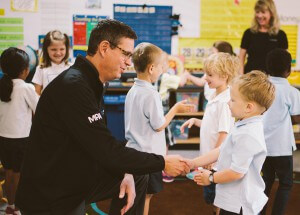November 17, 2016
by Dr. Bill Hudson, Head of School
Like many of you, I’ve spent a good amount of time lately thinking about gratitude. As Thanksgiving approaches, we naturally contemplate the goodness in our lives. Such reflection takes us outside of ourselves to acknowledge the experiences, events, and people in our lives that bring us joy.
There is a large, and rapidly growing, body of research demonstrating that gratitude is strongly and consistently associated with greater happiness. Gratitude helps people feel more positive emotions, relish good experiences, improve their health, deal with adversity, and build strong relationships. In the “How of Happiness,” researcher Sonja Lyubomirsky defines happiness as “the experience of joy, contentment, or positive well-being, combined with a sense that one’s life is good, meaningful, and worthwhile.”
Happiness abounds at MPA. The joy of learning is our lived reality each day. A parent once told me that her Lower School child woke up sad one Saturday. When asked why he was upset, the child replied, “If it’s Saturday, then I won’t be going to school today.” I know this sentiment firsthand. My daughter Ari, a new fifth grader, is very excited each day to come to school. As a parent, her joy is my joy.
At MPA, the joy of learning is fostered intentionally and its impact is profound. With a careful balance between the arts, academics, and athletics and a holistic approach to character development, we are very conscious of the well-being of our students. Martin Seligman, Zellerbach family professor of psychology as well as the director of the positive psychology center at the University of Pennsylvania, developed the PERMA model of well-being. As I compare it to our community and our mission, I believe the model truly reflects what exists at Mounds Park Academy:
- Positive Emotions: enjoyment that comes from intellectual stimulation and creativity;
- Engagement: finding our passion and immersing ourselves in it;
- Relationships: forging authentic connections with family, peers and friends;
- Meaning: understanding the impact of our work that gives us purpose;
- Achievement: a sense of accomplishment that leads to a sense of pride and fulfillment.
In preparation for this message, I asked our faculty and staff to share with me what they are grateful for this season. As you might expect, they named their students and colleagues as sources of joy and gratitude. They also mentioned teaching—their ability to do what they love—as meaningful. And, several mentioned how proud they are to be part of this strong community.
We face many challenges in our world today. Even though I am, by nature, an optimist, I sometimes catch myself worrying about the life my children have in store for them. But my concerns are given context through gratitude. Melody Beattie, author of “Co-Dependent No More,” wrote, “Gratitude turns what we have into enough, and more. It turns denial into acceptance, chaos into order, confusion into clarity … it makes sense of our past, brings peace for today, and creates a vision for tomorrow.”
The word gratitude is derived from the Latin word gratia, which means grace, graciousness, or gratefulness. In this season of thanks, please know that you and your family are in my thoughts. I am profoundly grateful for your commitment to our school and the many and varied ways you demonstrate that commitment. Your children, and my amazing colleagues, bring great joy into my life. I feel an incredible sense of gratitude to be of service to this exceptional community. Happy Thanksgiving!